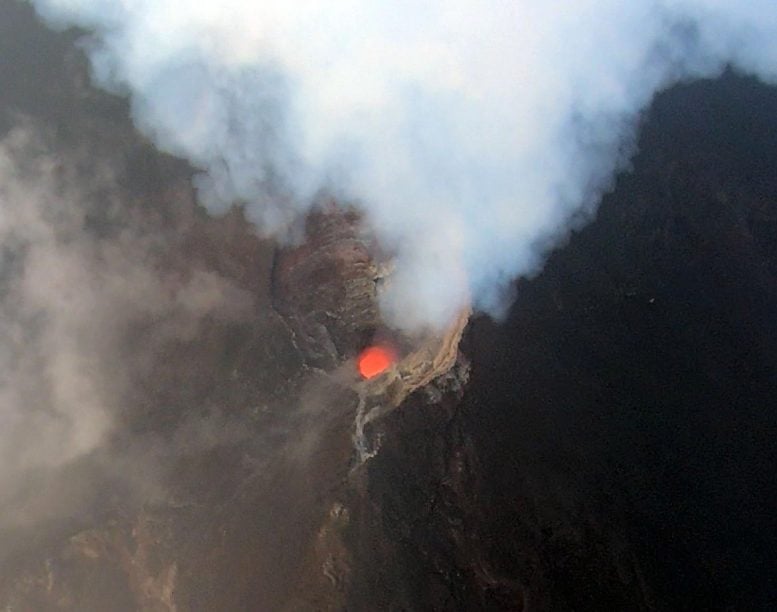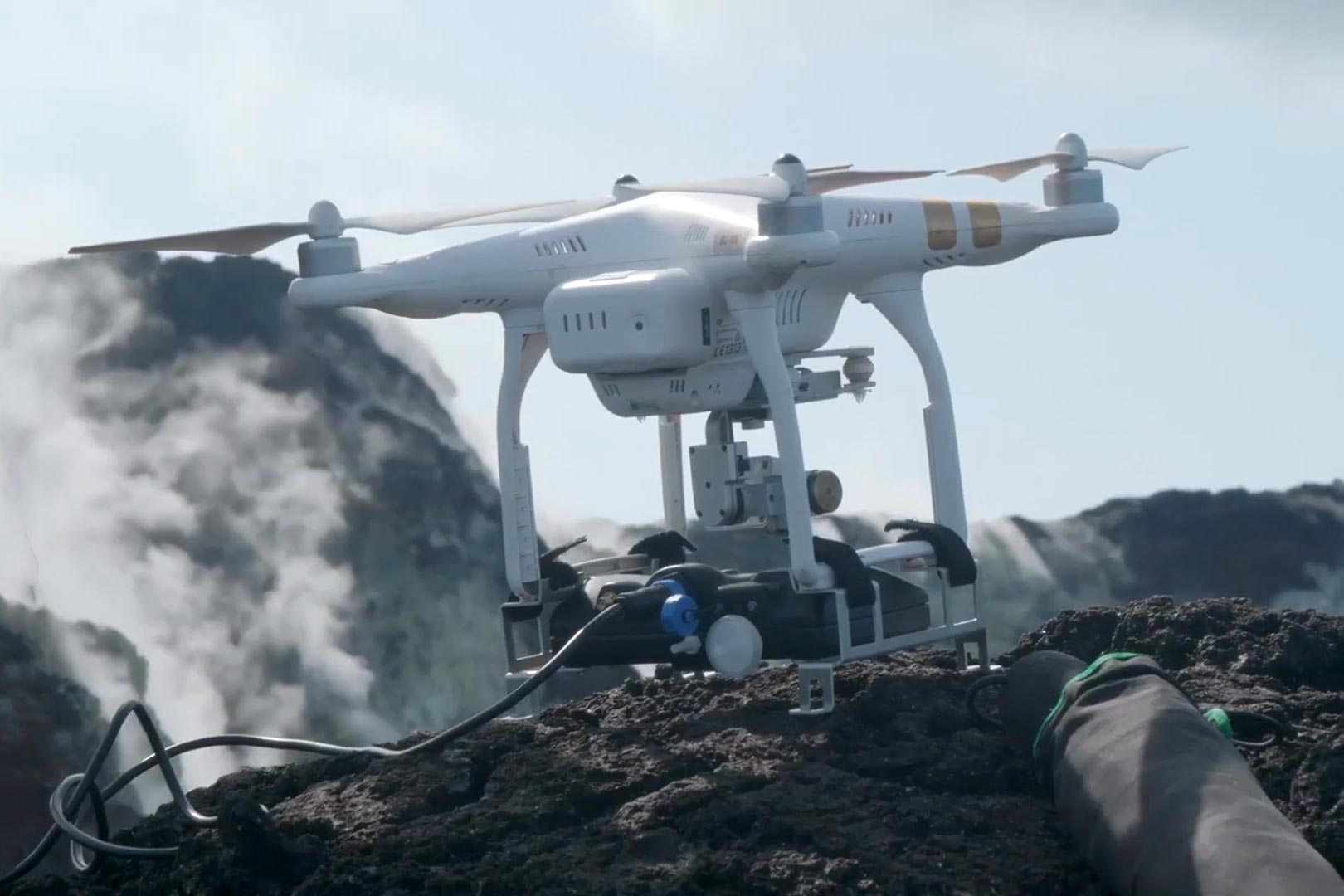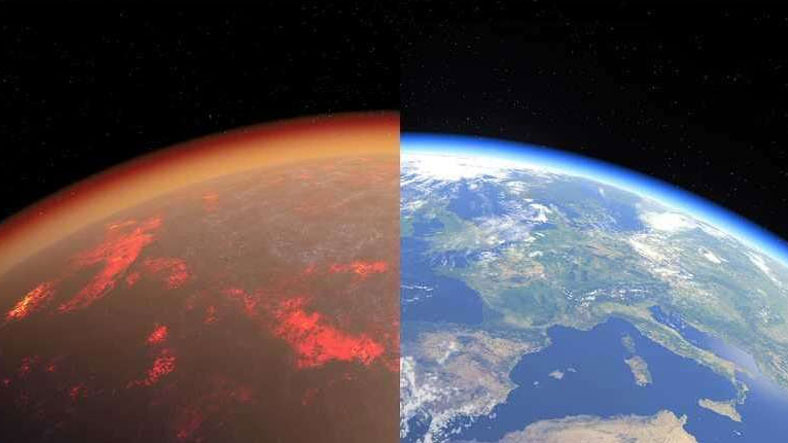Aerial view of the active ventilation and gas plume of the Manam volcano in Papua New Guinea from a fixed-wing drone at an altitude of 2300 m. Photo credit: Emma Liu / TOP
Customized drones, developed by an international team led by University College London, have collected data from never-before-explored volcanoes, which enables local communities to better predict future eruptions.
Cutting-edge research at Manam Volcano in Papua New Guinea is improving scientists’ understanding of how volcanoes contribute to the global carbon cycle, which is vital to sustaining life on earth.
The team’s results, published in Science Advances, show for the first time how it is possible to combine measurements from air, earth and space to learn more about the most inaccessible, highly active volcanoes on the planet.
The ABOVE project included specialists from Great Britain, the USA, Canada, Italy, Sweden, Germany, Costa Rica, New Zealand and Papua New Guinea in the fields of volcanology and aerospace engineering.
They have jointly developed solutions to the challenges of measuring gas emissions from active volcanoes using modified long-range drones.

Aerial view in the active vent of Manam volcano in Papua New Guinea with molten magma near the surface. Photo credit: Emma Liu / TOP
By combining in-situ air measurements with results from satellites and ground-based remote sensors, researchers can collect a much larger data set than previously possible. This allows them to remotely monitor active volcanoes and better understand how much carbon dioxide (CO2) is released by volcanoes around the world and, most importantly, where that carbon comes from.
The Manam volcano with a diameter of 10 km is located on an island 13 km off the northeast coast of the mainland at 1,800 m above sea level.
Previous studies have shown that it is one of the world’s largest emitters of sulfur dioxide, but nothing was known about its CO2 emissions.
Volcanic CO2 emissions are difficult to measure due to high concentrations in the background atmosphere. Measurements must be taken very close to active vents. In dangerous volcanoes like Manam, drones are the only way to safely collect samples. However, in volcanic environments, drone flights out of line of sight have rarely been attempted.
Using miniaturized gas sensors, spectrometers, and sampling devices that automatically trigger to open and close, the team was able to fly the drone 2 km up and 6 km away to reach the summit of Manam, where gas samples to be analyzed were taken within hours.
Calculating the relationship between sulfur and carbon dioxide levels in a volcano’s emissions is critical to determining the likelihood of an eruption, as volcanologists can determine the location of its magma.
Manam’s last major eruptions between 2004 and 2006 devastated large parts of the island, displacing around 4,000 people on the mainland. Their crops have been destroyed and the water supply contaminated.
The project manager Dr. Emma Liu (UCL Geosciences) said, “Manam has not been studied in detail, but we could see from satellite data that it is producing strong emissions. The Inland Volcano Monitoring Institute resources are sparse and the team has an incredible workload, but they really helped us make the connections with the community living on Manam Island. ”
After the fieldwork, the researchers raised funds to buy computers, solar panels, and other technology so the local community – which has now formed a civil protection group – can communicate via satellite from the island and provide Rabaul Volcanological training on drone operations to assist Observatory staff of their surveillance efforts.
TOP was part of the Deep Carbon Observatory (DCO), a global community of scientists who spent a decade looking for a better understanding of carbon on Earth.
Volcanic emissions are a critical stage in the earth’s carbon cycle – the movement of carbon between land, atmosphere and ocean – but CO2 measurements have so far been limited to a relatively small number of the world’s estimated 500 degassing volcanoes.
Understanding the factors that control volcanic carbon emissions in the present will reveal how the climate has changed in the past and, therefore, how it may respond to current human influences in the future.
Co-author Professor Alessandro Aiuppa (University of Palermo) described the results as “a real advance in our field” and added: “Ten years ago one could only have guessed and guessed Manam’s CO2 emissions.
“When you factor in the total carbon released by global volcanism, it accounts for less than one percent of the total emissions budget dominated by human activities. In a few centuries people behave like thousands of volcanoes. If we keep pumping carbon into the atmosphere, monitoring and predicting eruptions with aerial gas observations will become even more difficult. ”
Co-author Professor Tobias Fischer (University of New Mexico) added: “To understand the drivers of climate change, one has to understand the carbon cycle on earth.
“We wanted to quantify the carbon emissions from this very large carbon dioxide emitter. We had very little data on the carbon isotopic composition that would identify the carbon source and whether it was the mantle, crust, or sediment. We wanted to know where this carbon comes from. ”
Reference: “Air strategies promote the measurement of volcanic gas in inaccessible, strongly degassing volcanoes” by EJ Liu, A. Aiuppa, A. Alan, S. Arellano, M. Bitetto, N. Bobrowski, S. Carn, R. Clarke, E. Corrales, JM de Moor, JA Diaz, M. Edmonds, TP Fischer, J. Freer, GM Fricke, B. Galle, G. Gerdes, G. Giudice, A. Gutmann, C. Hayer, I. Itikarai, J. Jones , E. Mason, BT McCormick Kilbride, K. Mulina, S. Nowicki, K. Rahilly, T. Richardson, J. Rüdiger, CI Schipper, IM Watson and K. Wood, October 30, 2020, Advances in science.
DOI: 10.1126 / sciadv.abb9103
ABOVE was funded by the Alfred P. Sloan Foundation.



